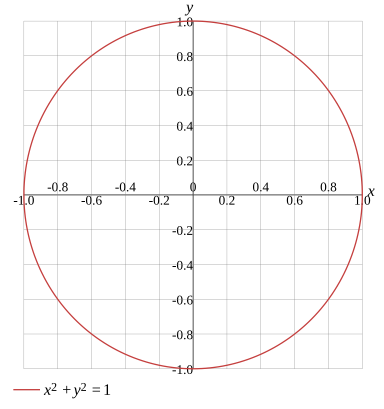Question
Identify the conic
Find the radius of the circle
Find the center of the circle
r=1
Rewrite in standard form
x2+y2=1
Solution
r=1
Show Solution

Solve the equation
Solve for x
Solve for y
x=1−y2x=−1−y2
Evaluate
x2+y2=1
Move the expression to the right-hand side and change its sign
x2=1−y2
Take the root of both sides of the equation and remember to use both positive and negative roots
x=±1−y2
Solution
x=1−y2x=−1−y2
Show Solution

Testing for symmetry
Testing for symmetry about the origin
Testing for symmetry about the x-axis
Testing for symmetry about the y-axis
Symmetry with respect to the origin
Evaluate
x2+y2=1
To test if the graph of x2+y2=1 is symmetry with respect to the origin,substitute -x for x and -y for y
(−x)2+(−y)2=1
Evaluate
More Steps


Evaluate
(−x)2+(−y)2
Rewrite the expression
x2+(−y)2
Rewrite the expression
x2+y2
x2+y2=1
Solution
Symmetry with respect to the origin
Show Solution

Find the first derivative
Find the derivative with respect to x
Find the derivative with respect to y
dxdy=−yx
Calculate
x2+y2=1
Take the derivative of both sides
dxd(x2+y2)=dxd(1)
Calculate the derivative
More Steps


Evaluate
dxd(x2+y2)
Use differentiation rules
dxd(x2)+dxd(y2)
Use dxdxn=nxn−1 to find derivative
2x+dxd(y2)
Evaluate the derivative
More Steps


Evaluate
dxd(y2)
Use differentiation rules
dyd(y2)×dxdy
Use dxdxn=nxn−1 to find derivative
2ydxdy
2x+2ydxdy
2x+2ydxdy=dxd(1)
Calculate the derivative
2x+2ydxdy=0
Move the expression to the right-hand side and change its sign
2ydxdy=0−2x
Removing 0 doesn't change the value,so remove it from the expression
2ydxdy=−2x
Divide both sides
2y2ydxdy=2y−2x
Divide the numbers
dxdy=2y−2x
Solution
More Steps


Evaluate
2y−2x
Cancel out the common factor 2
y−x
Use b−a=−ba=−ba to rewrite the fraction
−yx
dxdy=−yx
Show Solution

Find the second derivative
Find the second derivative with respect to x
Find the second derivative with respect to y
dx2d2y=−y3y2+x2
Calculate
x2+y2=1
Take the derivative of both sides
dxd(x2+y2)=dxd(1)
Calculate the derivative
More Steps


Evaluate
dxd(x2+y2)
Use differentiation rules
dxd(x2)+dxd(y2)
Use dxdxn=nxn−1 to find derivative
2x+dxd(y2)
Evaluate the derivative
More Steps


Evaluate
dxd(y2)
Use differentiation rules
dyd(y2)×dxdy
Use dxdxn=nxn−1 to find derivative
2ydxdy
2x+2ydxdy
2x+2ydxdy=dxd(1)
Calculate the derivative
2x+2ydxdy=0
Move the expression to the right-hand side and change its sign
2ydxdy=0−2x
Removing 0 doesn't change the value,so remove it from the expression
2ydxdy=−2x
Divide both sides
2y2ydxdy=2y−2x
Divide the numbers
dxdy=2y−2x
Divide the numbers
More Steps


Evaluate
2y−2x
Cancel out the common factor 2
y−x
Use b−a=−ba=−ba to rewrite the fraction
−yx
dxdy=−yx
Take the derivative of both sides
dxd(dxdy)=dxd(−yx)
Calculate the derivative
dx2d2y=dxd(−yx)
Use differentiation rules
dx2d2y=−y2dxd(x)×y−x×dxd(y)
Use dxdxn=nxn−1 to find derivative
dx2d2y=−y21×y−x×dxd(y)
Calculate the derivative
More Steps


Evaluate
dxd(y)
Use differentiation rules
dyd(y)×dxdy
Use dxdxn=nxn−1 to find derivative
dxdy
dx2d2y=−y21×y−xdxdy
Any expression multiplied by 1 remains the same
dx2d2y=−y2y−xdxdy
Use equation dxdy=−yx to substitute
dx2d2y=−y2y−x(−yx)
Solution
More Steps


Calculate
−y2y−x(−yx)
Multiply the terms
More Steps


Evaluate
x(−yx)
Multiplying or dividing an odd number of negative terms equals a negative
−x×yx
Multiply the terms
−yx×x
Multiply the terms
−yx2
−y2y−(−yx2)
Subtract the terms
More Steps


Simplify
y−(−yx2)
If a negative sign or a subtraction symbol appears outside parentheses, remove the parentheses and change the sign of every term within the parentheses
y+yx2
Reduce fractions to a common denominator
yy×y+yx2
Write all numerators above the common denominator
yy×y+x2
Multiply the terms
yy2+x2
−y2yy2+x2
Divide the terms
More Steps


Evaluate
y2yy2+x2
Multiply by the reciprocal
yy2+x2×y21
Multiply the terms
y×y2y2+x2
Multiply the terms
y3y2+x2
−y3y2+x2
dx2d2y=−y3y2+x2
Show Solution

Rewrite the equation
r=1r=−1
Evaluate
x2+y2=1
To convert the equation to polar coordinates,substitute x for rcos(θ) and y for rsin(θ)
(cos(θ)×r)2+(sin(θ)×r)2=1
Factor the expression
(cos2(θ)+sin2(θ))r2=1
Simplify the expression
r2=1
Evaluate the power
r=±1
Simplify the expression
r=±1
Solution
r=1r=−1
Show Solution

Graph
